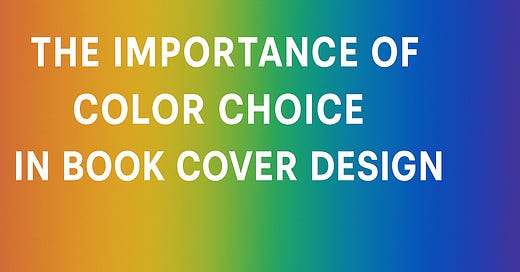#PublishingReinvented 251 What Color is Your Cover?
The importance of color choice when designing a book cover cannot be overstated.
Get it wrong and your sales will be impacted and you might start questioning your writing ability. Horrors!
All because you used inappropriate colors on your cover!
Colors really do speak a visual language, resonating with readers on an emotional level, often shaping their initial perceptions and influencing their purchasing decisions. Effective color selection captures attention but also conveys genre, tone, and the essence of a book’s story in an instant.
Colors elicit emotional responses universally, and these associations become powerful tools in book marketing.
Red, for example, evokes intensity, passion, excitement, and urgency. It's often used in thrillers, mysteries, and romances to create a sense of immediacy or emotional tension. A vivid red cover might indicate a gripping thriller, while softer shades might suggest romance or deep emotional narratives.
Blue conveys calmness, trust, and professionalism. It is extensively used in nonfiction, self-help, business, and spiritual books to impart reliability and authority. In fiction, blue hues can suggest tranquility or introspection, often suitable for literary or contemplative narratives. Darker blues may be chosen for more serious themes or mysteries, implying depth and sophistication.
Green symbolizes growth, nature, health, and harmony. Books with themes related to sustainability, wellness, nature, and personal growth often feature green prominently. Fantasy genres also utilize shades of green to evoke magic, enchantment, and mythical landscapes. A cover with lush greens immediately communicates a connection to nature or healing.
Yellow and orange represent optimism, creativity, warmth, and friendliness. These vibrant colors are attractive to younger audiences and commonly used in children’s literature, young adult novels, and creative nonfiction. They signal fun, adventure, positivity, and creativity, making them ideal for books aimed at inspiring or entertaining readers.
Purple is associated with imagination, spirituality, mystery, and royalty. It's a popular choice for fantasy, paranormal romance, historical fiction, and spiritual literature, implying depth, mysticism, and elegance. Purple covers often promise readers journeys into magical realms or stories involving nobility and grandeur.
Black is powerful, sophisticated, and authoritative. Frequently used in literary fiction, thrillers, horror, and nonfiction works that explore darker or profound topics, black immediately communicates seriousness, drama, and sometimes a touch of menace or mystery.
White suggests simplicity, clarity, purity, and space. It is often found in minimalistic designs for nonfiction, memoirs, and self-help books, as it conveys honesty, openness, and accessibility. White covers communicate to readers that the content is straightforward, clean, and trustworthy.
Pink carries associations with romance, femininity, compassion, and gentleness. It’s a common choice for romantic fiction, chick-lit, young adult romance, and books addressing themes of love, relationships, and emotional experiences. Soft pinks may suggest delicate or sweet narratives, while bolder shades indicate vibrant, contemporary stories.
Brown implies stability, tradition, ruggedness, and authenticity. It’s frequently chosen for historical novels, westerns, adventure narratives, or stories deeply rooted in cultural authenticity and heritage. Brown shades offer warmth, reliability, and a connection to earthiness and realism.
Aligning colors with genre conventions is critical. Fantasy often employs rich purples, blues, and greens, while thrillers favor darker, more intense palettes of black, red, and deep blues. Romance novels lean towards reds, pinks, and soft pastels, while nonfiction titles often opt for trustworthy blues, crisp whites, and reassuring greens.
Ultimately, the right color choice enhances visual storytelling, setting reader expectations and increasing the likelihood of engagement and purchase.
By carefully considering the emotional responses colors provoke and their genre-specific associations, designers and authors can craft book covers that resonate powerfully and effectively communicate the heart of their stories.
#PublishingReinvented is the Substack you’ve been looking for.
To subscribe to this newsletter, for those who may have received this email as a trial, click below for monthly and annual options:




